★★★★½
“From bad to hearse…”
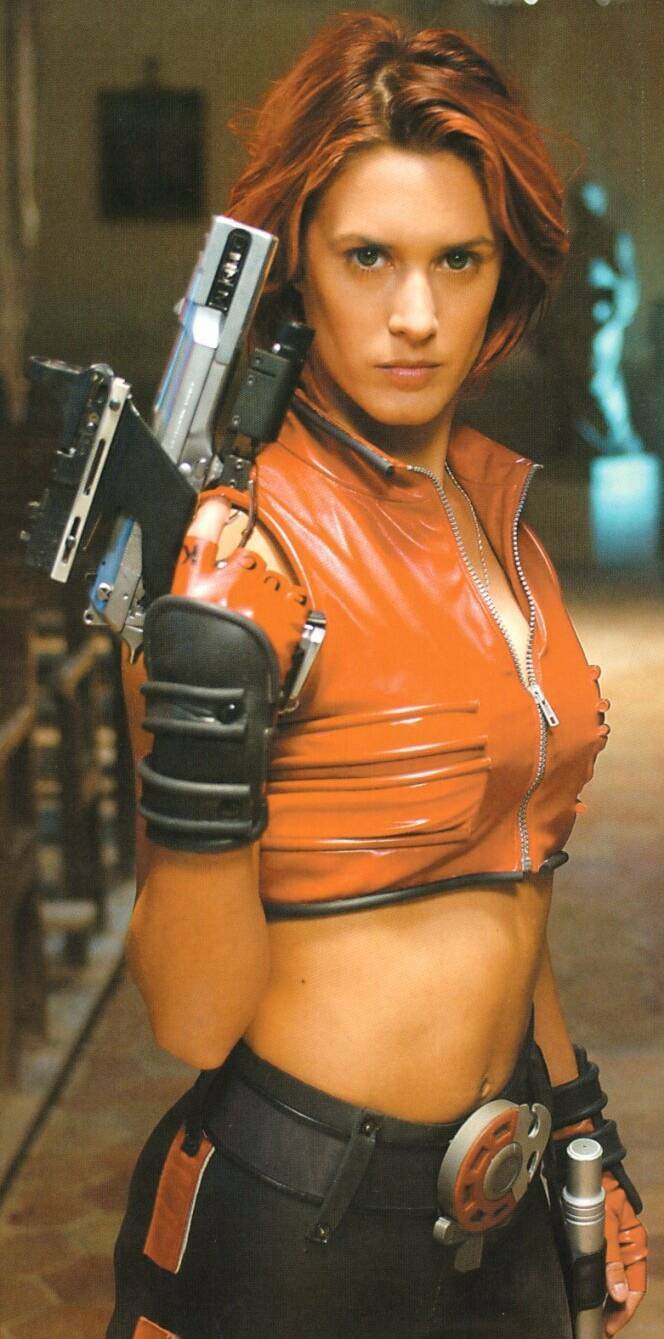
 It has been a long time since we’ve enjoyed a film so much. Right from the start, which shows a bride, in her wedding-dress, being stalked by a demon (or does it?), this grabbed our attention, and hardly let up for a second until the finale. I have to say, the odds are that you will either love this film, or fail entirely to ‘get’ what it’s trying to do and dismiss it as a lame Buffy ripoff. But in our living-room, it got four enthusiastic thumbs-up from the viewing panel, and seems like the perfect complement to beer and pizza.
It has been a long time since we’ve enjoyed a film so much. Right from the start, which shows a bride, in her wedding-dress, being stalked by a demon (or does it?), this grabbed our attention, and hardly let up for a second until the finale. I have to say, the odds are that you will either love this film, or fail entirely to ‘get’ what it’s trying to do and dismiss it as a lame Buffy ripoff. But in our living-room, it got four enthusiastic thumbs-up from the viewing panel, and seems like the perfect complement to beer and pizza.
After the opening, things for Mallory (Bonamy) go from bride to worse. [Hey, so I squeeze every drop of use from a pun. Sue me.] She’s now head of a team that investigates, and deals with, paranormal attacks – France seems to be the only country which has realised that such evil critters actually exist. She loses one member of her squad while repelling ghouls at a convent, and at the same time, new pope Hieronymus I (Spielvogel) is being kidnapped. She discovers he’s being held hostage in a nightmarish alternate dimension, so has to follow, and save the world from demonic invasion through the Hellmou…er, portal which is going to be opened, oh, any minute now.
There’s no doubt that director Julien Magnat was influenced by all the “right” films when it came to constructing his heroine: Mallory has Lola’s hair, Buffy’s martial-arts skill, the intensity of Michelle Rodriguez, and some of Resident Evil‘s Alice too. But none of them ever had gloves with ‘FUCK EVIL’ on the knuckles, drove a hearse, ran over black cats because “you never know”, or wore a tight, red waistcoat with a big ‘M’ embossed on the back [how there’s room in it for a large gun remains a charming mystery!]. Portrayed by Bonamy, who is unknown outside France (her only English-language role is a schoolgirl in Merchant-Ivory’s Jefferson in Paris), Mallory comes across as a convincing and original entry in the action heroine genre.
The other members of the team are hardly less imaginative – or, at least, the females, the guys are nowhere near so colourful or interesting. Completing the heroic trio are Vena Cava (Ribier – I think the character’s name is a Diamanda Galas reference), a six-foot “action transvestite”, as Eddie Izzard would say, an explosives expert with automatic weaponry in her platform soles, and Talking Tina, a mute telepath who can transfer her consciousness into animals or the dumber end of humanity. Both are excellent supporting characters; in a kinder universe, they would merit franchises of their own, Cava, in particular,
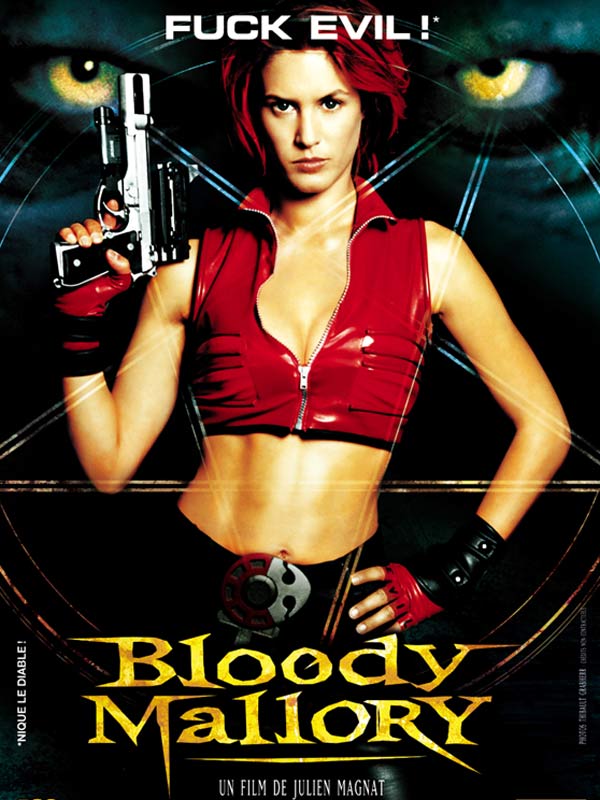 Less effective or interesting are the men, and it’s abundantly clear where Magnat’s passion lies. Father Carras (Collado), the Vatican priest and papal bodyguard is bland and colourless, despite having a name borrowed from The Exorcist. The best is actually Mallory’s demon husband (Julien Boisselier), now stuck in limbo after the murderous end to their marriage. The pair have a relationship which is genuinely touching, in a way which Joss Whedon could only dream of.
Less effective or interesting are the men, and it’s abundantly clear where Magnat’s passion lies. Father Carras (Collado), the Vatican priest and papal bodyguard is bland and colourless, despite having a name borrowed from The Exorcist. The best is actually Mallory’s demon husband (Julien Boisselier), now stuck in limbo after the murderous end to their marriage. The pair have a relationship which is genuinely touching, in a way which Joss Whedon could only dream of.
On the side of evil, again, the femmes rule, with Valentina Vargas and Sophie Tellier, as Lady Valentine and her shape-shifting sidekick, Morphine, giving performances which are suitably excessive and on the money. However, the climax of the film is disappointing, largely because Mallory has no genuine nemesis, with whom she can go toe-to-toe at the end – who’s she going to beat up, the Pope? [Actually, given his intolerant statements, you’ll likely be rooting for this from the get-go]
Some of the effects definitely leave a little to be desired – the demon masks look extremely rubbery, although personally, it reminded me of another energetic B-favourite, Rabid Grannies. However, the digital effects are great, particularly the exploding bodies; we especially loved the effect of Mallory’s cross-shaped holy-water spritzer. There were many moments where we went “Cool!”, at little things like the blood-red, swirling sky in the demon realm, the evaporation of Mallory’s husband into a cloud of rose petals, or the transformations of Morphine.
The attention paid to details like these helps immeasurably, and Magnat succeds admirably in his avowed intention of making something which has the look and feel of a Japanese comic-book come to life, with a lot of Dutch angles [this week’s pretentious technical term – it means the camera’s not level]. There’s almost no natural light at all, and each character has their own colour scheme: red/black for Mallory, blue/purple for Vena, burgundy/gold for Lady Valentine. Indeed, the soundtrack is by Kenji Kawai, whose credits include Ghost in the Shell.
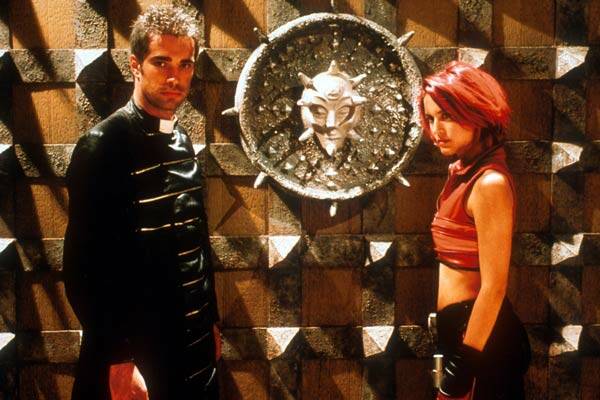 Perhaps what we enjoyed most was the balance Magnat strikes between parody and drama. This is clearly not intended to be taken seriously – but the characters keep such admirably straight faces, that it became very easy to buy into the whole mythos, which in reality wouldn’t stand up to ten seconds of close scrutiny. There’s none of the self-awareness that plagued the later seasons of Buffy, and nor is there much angst or whining. The heroine has a mission to complete, and gets on with it, in a refreshingly straightforward manner.
Perhaps what we enjoyed most was the balance Magnat strikes between parody and drama. This is clearly not intended to be taken seriously – but the characters keep such admirably straight faces, that it became very easy to buy into the whole mythos, which in reality wouldn’t stand up to ten seconds of close scrutiny. There’s none of the self-awareness that plagued the later seasons of Buffy, and nor is there much angst or whining. The heroine has a mission to complete, and gets on with it, in a refreshingly straightforward manner.
Magnat’s wants his next project to be a return to The All-New Adventures of Chastity Blade, expanding on a 32-minute short film he made in the summer of 1999. This starred Lisa (Nightmare on Elm Street) Wilcox, playing a housewife who finds herself sucked into the world of the titular 1930’s pulp-fiction heroine after getting a bullet in the head. If he brings the same sense of style and wit to that concept as we enjoyed here, it promises to be worth our attention. Meanwhile, Mallory was picked up by Lion’s Gate in November 2002, and was passed by the MPAA (R, natch) in April last year – the same week as Gigli! Since then, nothing. However, a quick search on Ebay reveals it’s available from, ahem, the usual sources. [Update: It’s due a September 2005 release on DVD] And if you see only one film about a red-headed, hearse-driving demon-hunter this, or any year, Bloody Mallory should definitely be it.
Dir: Julien Magnat
Star: Olivia Bonamy, Jeffrey Ribier, Adrià Collado, Laurent Spielvogel
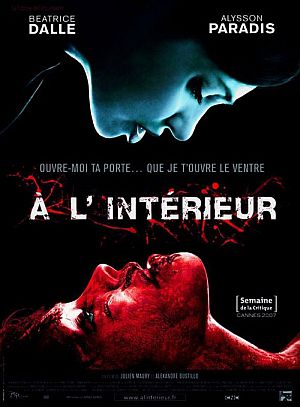
 The ‘final girl’ is a well-worn concept in horror: the last survivor, typically the “good” girl, finally fights back against the assailant in the movie’s climax. It is isn’t normally enough to merit inclusion here, since it’s usually a relatively minor aspect of the film. Here, however, not only is it just about the entire film, the main theme – motherhood and the instincts it arouses – is entirely feminine. Aliens, and Ripley’s surrogate parenting of Newt, would be another example. And it’s also a rarity in the horror genre for both protagonist and antagonist to be female, but the threat here certainly deserves to be up there with Freddy, Michael, Jason and their cousins.
The ‘final girl’ is a well-worn concept in horror: the last survivor, typically the “good” girl, finally fights back against the assailant in the movie’s climax. It is isn’t normally enough to merit inclusion here, since it’s usually a relatively minor aspect of the film. Here, however, not only is it just about the entire film, the main theme – motherhood and the instincts it arouses – is entirely feminine. Aliens, and Ripley’s surrogate parenting of Newt, would be another example. And it’s also a rarity in the horror genre for both protagonist and antagonist to be female, but the threat here certainly deserves to be up there with Freddy, Michael, Jason and their cousins.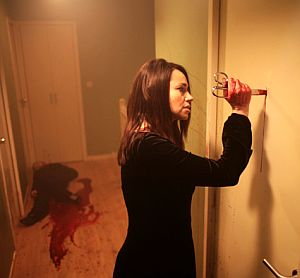 Let me be perfectly clear: this is hardcore horror of the most unrelenting sort, completely unsuitable for those of a nervous disposition, and particularly pregnant women. In the 1980’s, Dalle was a sexpot, for her role in Betty Blue, but you can flush all memory of that down the toilet: here, she has a feral, near-demonic intensity, and god help anyone who is unfortunate enough to get in her way. Particularly the men, who are disposed of with complete dispassion and brutality; as the film goes on, her relationship with Sarah becomes complex, and more a case of, “I’m taking your baby, and we can do this the hard way or… Well, really, that’s all there is. Sorry.” Friends, family, even an entire patrol of cops – no-one can help Sarah. She’s completely on her own, and her fate is entirely in her own hands.
Let me be perfectly clear: this is hardcore horror of the most unrelenting sort, completely unsuitable for those of a nervous disposition, and particularly pregnant women. In the 1980’s, Dalle was a sexpot, for her role in Betty Blue, but you can flush all memory of that down the toilet: here, she has a feral, near-demonic intensity, and god help anyone who is unfortunate enough to get in her way. Particularly the men, who are disposed of with complete dispassion and brutality; as the film goes on, her relationship with Sarah becomes complex, and more a case of, “I’m taking your baby, and we can do this the hard way or… Well, really, that’s all there is. Sorry.” Friends, family, even an entire patrol of cops – no-one can help Sarah. She’s completely on her own, and her fate is entirely in her own hands.




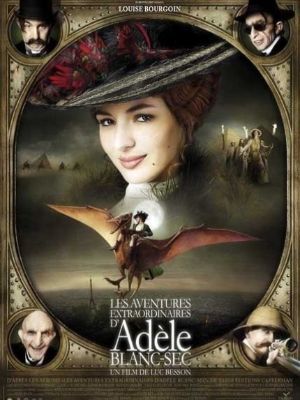 Good to see Besson back in the director’s chair. Outside of the kids’ Arthur series, the only movie he personally helmed in the 2000’s was Angel-A, but Besson has been delivering action heroines for 20 years. Most obviously with the hugely-influential Nikita, but also in The Messenger and, to some extent The Fifth Element and Leon. Here, he goes back to just before the first World War, where journalist Adèle Blanc-Sec (Bourgoin) is kinda like a proto-Lara, whizzing around the globe in search of adventure. She heads to Egypt to grab the mummy belonging to Ramses’s physician: she’s been working with Prof. Ménard (Nahon), who has discovered how to bring the dead back to life, and wants to use the arcane knowledge the mummy possesses to help her sister, who has been in a coma for five years. But Ménard, unwilling to wait, tests his powers on a prehistoric egg: the resulting pterodactyl escapes from the museum where it is housed, and terrorizes Paris. Detective Caponi (Lellouche) is on that case…
Good to see Besson back in the director’s chair. Outside of the kids’ Arthur series, the only movie he personally helmed in the 2000’s was Angel-A, but Besson has been delivering action heroines for 20 years. Most obviously with the hugely-influential Nikita, but also in The Messenger and, to some extent The Fifth Element and Leon. Here, he goes back to just before the first World War, where journalist Adèle Blanc-Sec (Bourgoin) is kinda like a proto-Lara, whizzing around the globe in search of adventure. She heads to Egypt to grab the mummy belonging to Ramses’s physician: she’s been working with Prof. Ménard (Nahon), who has discovered how to bring the dead back to life, and wants to use the arcane knowledge the mummy possesses to help her sister, who has been in a coma for five years. But Ménard, unwilling to wait, tests his powers on a prehistoric egg: the resulting pterodactyl escapes from the museum where it is housed, and terrorizes Paris. Detective Caponi (Lellouche) is on that case…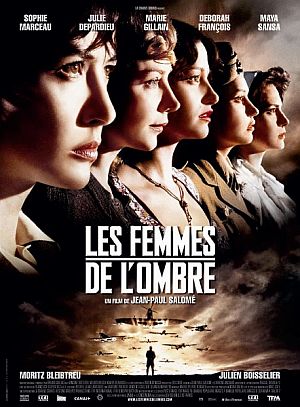
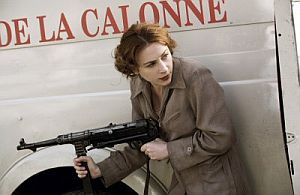 It’s a solid piece of action/drama, which managed to keep both of us awake, despite a session earlier in the evening at the “all you can eat” fish fry; normally, that requires 30,000 Volts to keep us from sliding into post-gluttony unconsciousness. I think Chris enjoyed the movie a little more: I was somewhat on the fence about giving it the seal, finding some of the plotting a little convoluted and occasionally implausible, but her endorsement of this as “great” provided sufficient impetus. Marceau is particularly good, exuding steely resolve to hold the team together, and Bleibtreu makes an excellent foil, coming across as equally smart and committed as Louise. Their conflict is the glue that binds the story together, and makes it one of the best efforts in the wartime heroine genre to date.
It’s a solid piece of action/drama, which managed to keep both of us awake, despite a session earlier in the evening at the “all you can eat” fish fry; normally, that requires 30,000 Volts to keep us from sliding into post-gluttony unconsciousness. I think Chris enjoyed the movie a little more: I was somewhat on the fence about giving it the seal, finding some of the plotting a little convoluted and occasionally implausible, but her endorsement of this as “great” provided sufficient impetus. Marceau is particularly good, exuding steely resolve to hold the team together, and Bleibtreu makes an excellent foil, coming across as equally smart and committed as Louise. Their conflict is the glue that binds the story together, and makes it one of the best efforts in the wartime heroine genre to date.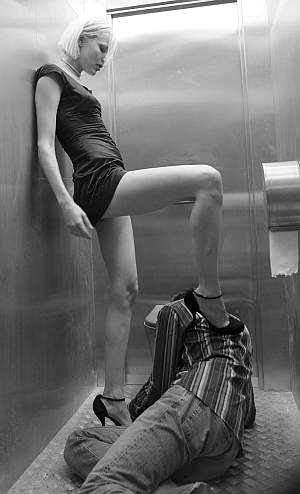 Andre (Debbouse) is at the end of his tether, owing large amounts of money to at least three separate gangs. He decides to end it all by leaping off a Parisian bridge into the Seine below, but is beaten to it by the tall, leggy blonde, Angela (Rasmussen, who you may remember in a bathroom stall with Rebecca Romijn-Stamos in the opening of Femme Fatale). His suicide forgotten, he jumps in to save her, and as they sit, dripping on the river-bank she vows that she will repay his selfless act by taking care of him. This may not be quite the way he expects; for example, she hijacks a negotiation with one of the mobsters to whom Andre owes money, marches upstairs and emerges not long afterwards, the debt apparently forgiven and with tens of thousands in bonus cash. Just as important as resolving his pecuniary problems are the emotional ones which plague Andre, and Angela is perhaps even more adept at addressing those: his lack of self-confidence, trust issues, an inability to give or receive love and so on. She sees the good person who is buried
Andre (Debbouse) is at the end of his tether, owing large amounts of money to at least three separate gangs. He decides to end it all by leaping off a Parisian bridge into the Seine below, but is beaten to it by the tall, leggy blonde, Angela (Rasmussen, who you may remember in a bathroom stall with Rebecca Romijn-Stamos in the opening of Femme Fatale). His suicide forgotten, he jumps in to save her, and as they sit, dripping on the river-bank she vows that she will repay his selfless act by taking care of him. This may not be quite the way he expects; for example, she hijacks a negotiation with one of the mobsters to whom Andre owes money, marches upstairs and emerges not long afterwards, the debt apparently forgiven and with tens of thousands in bonus cash. Just as important as resolving his pecuniary problems are the emotional ones which plague Andre, and Angela is perhaps even more adept at addressing those: his lack of self-confidence, trust issues, an inability to give or receive love and so on. She sees the good person who is buried 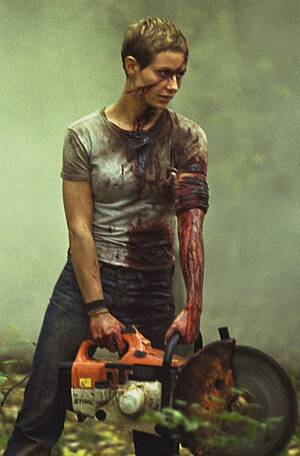 This Thanksgiving viewing – that may say more about our house than anything – was a suggestion by our teen daughter, which is somewhere between a incentive and a put-off. Normally, she won’t view anything with subtitles for more than two minutes; but her tastes are closer to Anchorman or The Notebook than French slasher pics. Reviews I read in advance were similarly split: either enthusiastic hype (“arguably the best horror movie since The Blair Witch Project” wrote
This Thanksgiving viewing – that may say more about our house than anything – was a suggestion by our teen daughter, which is somewhere between a incentive and a put-off. Normally, she won’t view anything with subtitles for more than two minutes; but her tastes are closer to Anchorman or The Notebook than French slasher pics. Reviews I read in advance were similarly split: either enthusiastic hype (“arguably the best horror movie since The Blair Witch Project” wrote  Despite influences all over the place – Assault on Precinct 13, Aliens, Night of the Living Dead, The Magnificent Seven – Siri takes and runs with them very effectively. Laborie (Farès) is a career soldier, tasked with transporting an Albanian gangster to his trial; but the convoy is ambushed, so she and her men hole up in a nearby warehouse on a deserted industrial estate. However, it is being robbed by brothers Santino (Magimel) and Nasser (Naceri), plus their crew – and the attackers have also followed them, intent on rescuing their boss. Can they survive until help arrives?
Despite influences all over the place – Assault on Precinct 13, Aliens, Night of the Living Dead, The Magnificent Seven – Siri takes and runs with them very effectively. Laborie (Farès) is a career soldier, tasked with transporting an Albanian gangster to his trial; but the convoy is ambushed, so she and her men hole up in a nearby warehouse on a deserted industrial estate. However, it is being robbed by brothers Santino (Magimel) and Nasser (Naceri), plus their crew – and the attackers have also followed them, intent on rescuing their boss. Can they survive until help arrives?
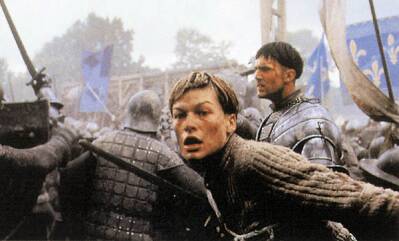 Joan’s capture, trial and execution are fairly close to the truth, though in reality, the King was less involved and more concerned for Joan than shown. It certainly is reasonable to suggest that a naive innocent such as Joan would have been used for political ends. Once she’d outlasted her usefulness – and with the king on the throne, she quickly became more a hindrance than a help – she would have needed to be disposed of. Must confess, I quite like the concept of Joan as a medieval version of Lee Harvey Oswald. Dustin Hoffman’s appearance as Joan’s conscience is another neat touch, and his sarcasm works well. Indeed, the film is one good performance from being excellent. The bad news is, it’s Jovovich who is the culprit (a messenger who deserves to be shot?), though Besson and co-writer Andrew Birkin perhaps warrant most of the criticism for twisting facts and characters in order to fit a predetermined goal. Their Joan is so far from the historical record, they’d have been better off placing their character in an entirely fictitious setting.
Joan’s capture, trial and execution are fairly close to the truth, though in reality, the King was less involved and more concerned for Joan than shown. It certainly is reasonable to suggest that a naive innocent such as Joan would have been used for political ends. Once she’d outlasted her usefulness – and with the king on the throne, she quickly became more a hindrance than a help – she would have needed to be disposed of. Must confess, I quite like the concept of Joan as a medieval version of Lee Harvey Oswald. Dustin Hoffman’s appearance as Joan’s conscience is another neat touch, and his sarcasm works well. Indeed, the film is one good performance from being excellent. The bad news is, it’s Jovovich who is the culprit (a messenger who deserves to be shot?), though Besson and co-writer Andrew Birkin perhaps warrant most of the criticism for twisting facts and characters in order to fit a predetermined goal. Their Joan is so far from the historical record, they’d have been better off placing their character in an entirely fictitious setting.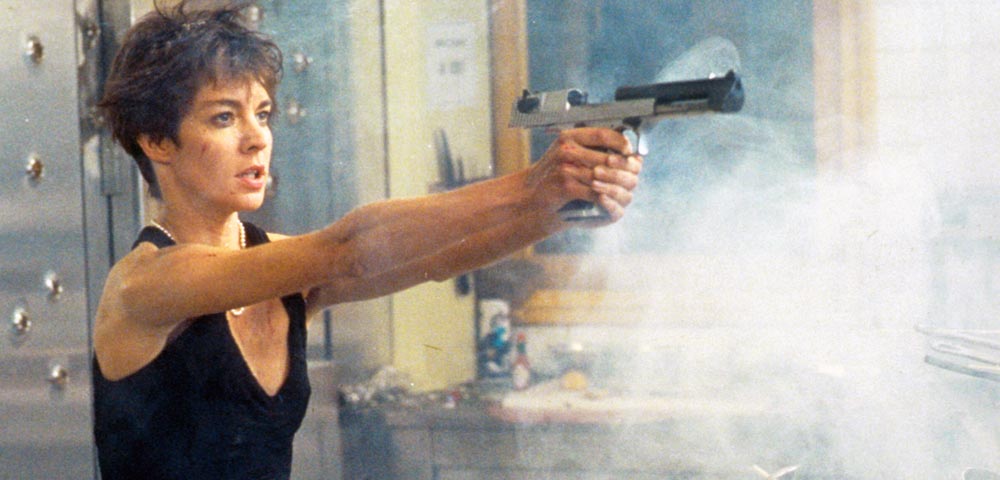
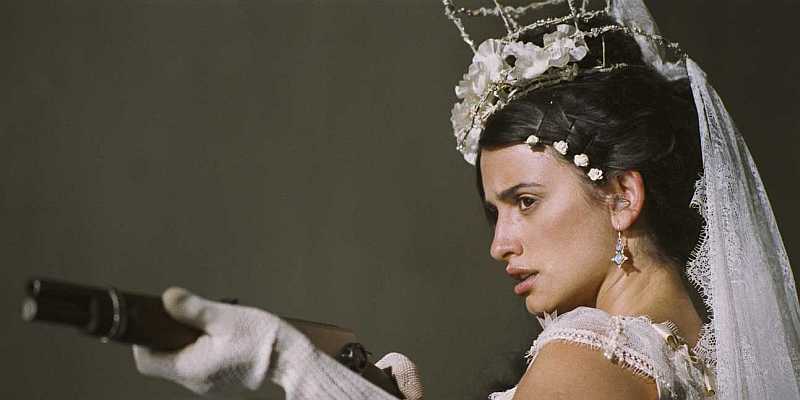 ★★★★
★★★★ When they start their campaign, Jackson brings in a specialist in the new ‘scientific method’ of criminal investigation, Quentin (Zahn), to help track down the bandidas. However, after discovering Sara’s father was poisoned, heis convinced by the pair that he is actually working for the wrong side, and comes across to join them. The latest security measures are defeated – with the aid of a pair of ice-skates! – and as a result a train is loaded with the Mexican government’s gold reserve, to ship it to safety in Mexico. The bandidas resolve to take the cargo, but Jackson and his gang are waiting for them…as is Quentin’s fiancée…
When they start their campaign, Jackson brings in a specialist in the new ‘scientific method’ of criminal investigation, Quentin (Zahn), to help track down the bandidas. However, after discovering Sara’s father was poisoned, heis convinced by the pair that he is actually working for the wrong side, and comes across to join them. The latest security measures are defeated – with the aid of a pair of ice-skates! – and as a result a train is loaded with the Mexican government’s gold reserve, to ship it to safety in Mexico. The bandidas resolve to take the cargo, but Jackson and his gang are waiting for them…as is Quentin’s fiancée… What did disappoint me was the action. I expected more from Besson, who helped give us such gems as The Transporter and District B-13, as well as the titles mentioned above, though a couple of moments stand out. There’s a bravura slow-motion scene in the final battle – bullets, knives, bodies and debris fly in a single shot, the camera panning back and forth to capture the carnage. But, the most amazing part is seeing a horse, with a rider on its back, climb a ladder. This was apparently a combination of training (the horse, with a stunt rider, walked up a specially-made set of stairs) and CGI work by Parisian FX house Macguff, to replace the stairs with a ladder, add dust and bounce, etc. It’s a throwaway moment, in a throwaway film, but is worthy of note, and applause.
What did disappoint me was the action. I expected more from Besson, who helped give us such gems as The Transporter and District B-13, as well as the titles mentioned above, though a couple of moments stand out. There’s a bravura slow-motion scene in the final battle – bullets, knives, bodies and debris fly in a single shot, the camera panning back and forth to capture the carnage. But, the most amazing part is seeing a horse, with a rider on its back, climb a ladder. This was apparently a combination of training (the horse, with a stunt rider, walked up a specially-made set of stairs) and CGI work by Parisian FX house Macguff, to replace the stairs with a ladder, add dust and bounce, etc. It’s a throwaway moment, in a throwaway film, but is worthy of note, and applause.













 It has been a long time since we’ve enjoyed a film so much. Right from the start, which shows a bride, in her wedding-dress, being stalked by a demon (or does it?), this grabbed our attention, and hardly let up for a second until the finale. I have to say, the odds are that you will either love this film, or fail entirely to ‘get’ what it’s trying to do and dismiss it as a lame Buffy ripoff. But in our living-room, it got four enthusiastic thumbs-up from the viewing panel, and seems like the perfect complement to beer and pizza.
It has been a long time since we’ve enjoyed a film so much. Right from the start, which shows a bride, in her wedding-dress, being stalked by a demon (or does it?), this grabbed our attention, and hardly let up for a second until the finale. I have to say, the odds are that you will either love this film, or fail entirely to ‘get’ what it’s trying to do and dismiss it as a lame Buffy ripoff. But in our living-room, it got four enthusiastic thumbs-up from the viewing panel, and seems like the perfect complement to beer and pizza. Less effective or interesting are the men, and it’s abundantly clear where Magnat’s passion lies. Father Carras (Collado), the Vatican priest and papal bodyguard is bland and colourless, despite having a name borrowed from The Exorcist. The best is actually Mallory’s demon husband (Julien Boisselier), now stuck in limbo after the murderous end to their marriage. The pair have a relationship which is genuinely touching, in a way which Joss Whedon could only dream of.
Less effective or interesting are the men, and it’s abundantly clear where Magnat’s passion lies. Father Carras (Collado), the Vatican priest and papal bodyguard is bland and colourless, despite having a name borrowed from The Exorcist. The best is actually Mallory’s demon husband (Julien Boisselier), now stuck in limbo after the murderous end to their marriage. The pair have a relationship which is genuinely touching, in a way which Joss Whedon could only dream of. Perhaps what we enjoyed most was the balance Magnat strikes between parody and drama. This is clearly not intended to be taken
Perhaps what we enjoyed most was the balance Magnat strikes between parody and drama. This is clearly not intended to be taken